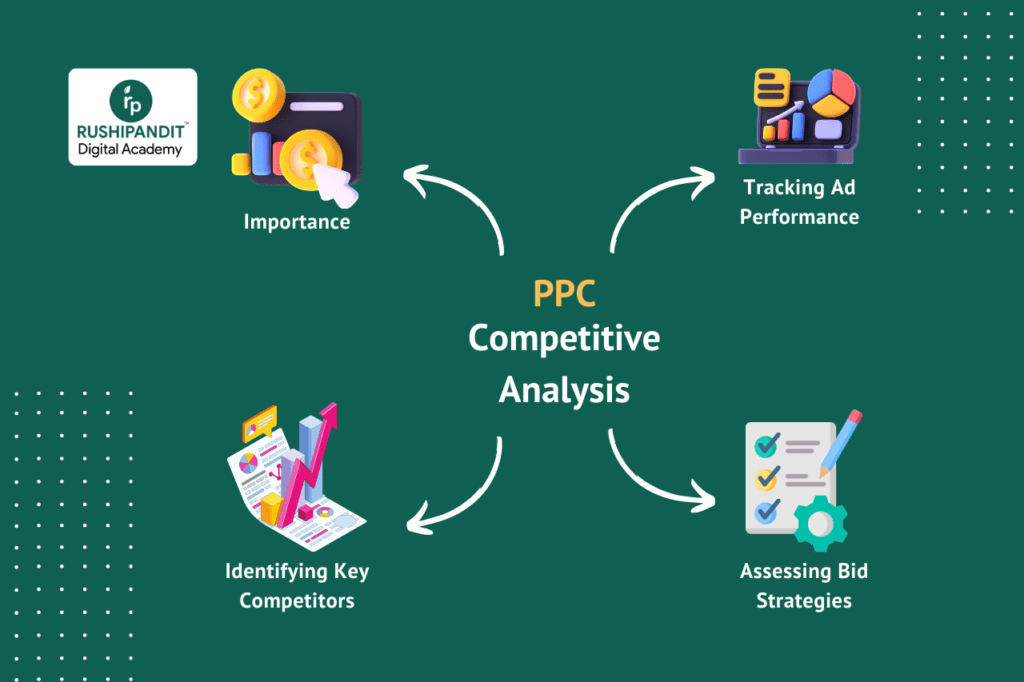Table of Contents
ToggleIntroduction
Pay-Per-Click (PPC) advertising is a potent instrument in the field of digital marketing that can increase conversions and drive targeted traffic. However, merely conducting PPC campaigns won’t cut it in the highly competitive world of online advertising. PPC Competitive Analysis is a deep field that requires study if one is to succeed. Analyzing the strategies of your rivals in order to pinpoint their advantages, disadvantages, and opportunities is part of this strategic process. To give you a competitive advantage in the digital sphere, we’ll delve into the nuances of performing a PPC competitive analysis in this article.
Understanding the Importance of PPC Competitive Analysis
Finding your main competitors is the first stage in performing a PPC competitive analysis. These are the competitors fighting for the same keywords and audience in your industry. Begin by generating a list of potential rivals using industry expertise and keyword research. Furthermore, use tools like Ahrefs, SpyFu, or SEMrush to find competitors you might have missed. After you’ve compiled a long list of rivals, rank them according to market share, ad visibility, and business relevance.
Identifying Key Competitors
Determine who your main rivals are before doing a PPC competitive analysis. These are the competitors in your niche fighting for the same keywords and audience. Create a list of potential rivals by conducting keyword research and industry analysis. Use tools like Ahrefs, SpyFu, and SEMrush to find competitors you might have missed. After compiling a thorough list, rank rivals according to their market share, ad visibility, and business relevance.
Analyzing Ad Copy and Messaging
After determining who your rivals are, analyze their messaging and ad text. Examine the language, tone, and value propositions that they employ in order to draw clients. Search for trends in calls-to-action, ad extensions, and keywords. Keep a watchful eye out for any offers or USPs that differentiate them from the competitors. You can improve the copy of your own advertisements to more effectively connect with your target audience by studying the messaging tactics used by your competitors.
Examining Ad Extensions and Formats
Examine the ad extensions and formats that your rivals are using, in addition to their copy. Ad extensions boost visibility and interaction by including links and other information in your ads. Examine the extensions—like callouts, sitelinks, and structured snippets—that your rivals are using. Additionally, pay attention to ad forms such as display ads, video ads, and responsive search ads. Gaining insight into how your rivals use these elements will help you come up with innovative ideas for your own advertising.
Assessing Bid Strategies and Budget Allocation
Because advertisers compete with one another for space on search engine results pages (SERPs), PPC advertising is by its very nature competitive. It is therefore essential to examine the bid strategy and financial commitments of your rivals. Determine which keywords they are aiming for and track the way they bid over time. Ad expenditure and position variations should be monitored since they can reveal information about the goals and effectiveness of a campaign. Furthermore, assess how rivals divide their spending among various campaigns, ad groups, and media outlets.
Monitoring Ad Placement and Positioning
PPC campaigns depend heavily on ad placement, with better positions usually generating more clicks and conversions. Keep an eye on where your competitors’ advertising show up in search results as part of your competitive study. Take note of where they are in relation to your own ads and evaluate how that affects visibility and click-through rates (CTRs). Additionally, examine where rivals’ advertisements are displayed on partner websites and ad networks. Your ad targeting and bidding methods can benefit from an understanding of their positioning techniques.
Tracking Ad Performance and Metrics
It’s critical to use analytics tools and important metrics to monitor the effectiveness of your competitors’ ads in addition to ad placement. Track data like cost-per-click (CPC), conversion rate, click-through rate (CTR), and return on ad spend (ROAS). Find out which of your competitors’ advertisements are bringing in the most visitors and conversions, as well as any patterns or unusual behavior over time. You can find areas where your PPC campaigns need to be optimized and improved by comparing your own stats to those of your competitors.
Staying Agile and Iterative
PPC Competitive Analysis is a continuous process of improvement and adaption rather than a one-time project. It is essential for your ideas and methods to change along with the digital landscape. Remain flexible and quick to react to shifts in the consumer landscape, the competitive landscape, and market dynamics. Keep an eye on and evaluate your rivals’ actions at all times, and be ready to adjust your own campaigns as necessary. In the dynamic world of pay-per-click advertising, you may stay ahead of the competition by adopting a philosophy of constant improvement.
Conclusion
Knowledge is power in the ever-changing world of PPC advertising. You may optimize your own campaigns for optimum impact by learning the art of PPC Competitive Analysis, which can provide you priceless insights into the strategies and tactics of your competitors. Every stage of the competitive analysis process presents an opportunity for development and innovation, from identifying important competitors to examining ad performance and metrics. With these insights at your disposal, you can outsmart your competitors and succeed more in the online market.


